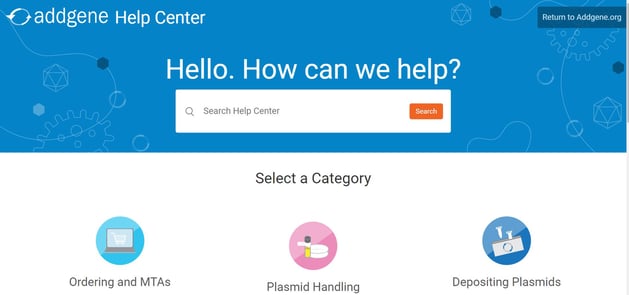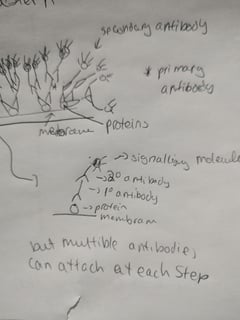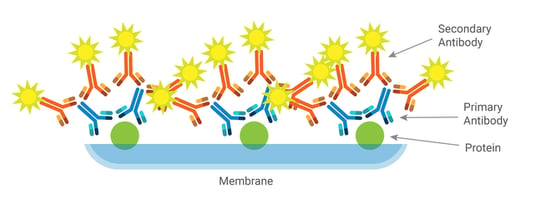Our educational content
Have you ever wondered how we choose topics for the Addgene blog? Or why we make certain videos? In this post, we invite you behind the scenes in our content writing process, and to even get involved yourself. You probably won’t be surprised to learn that Addgene’s mission statement extends beyond plasmids, AAVs, and antibodies to our content, website, Data Hub, and everything else we do!
The goal of Addgene’s educational content
Addgene truly believes that sharing speeds science, and our entire mission is to enable that process. Our repository of plasmids, AAVs, antibodies, and data allows scientists to easily and quickly access tools to further their research.
However, tools aren’t very useful if you don’t know how to use them. That’s where our content - the useful information on scientific literature, technical skills, and experiences from thousands of laboratories that makes up our Help Center, blog, website, social media, videos, newsletters, guides, and e-books – comes into play. Our goal is to provide informative content to help researchers in creating and sharing knowledge, related to the types of materials we help distribute and the research communities that we serve.
How we curate (and fact-check) our content
It should be no surprise then that a lot of our subject matter comes straight from you, whether you realize it or not! Many of our ideas come from social media conversations, conferences, and questions our scientific support staff receives – in fact, the blog originally started as a way to easily store and share in-depth answers to frequently asked questions.
We also want to tell you about things you didn’t know you wanted to know about, like research breakthroughs or cool new tools. And while this is in service of our mission, it’s also because Addgenies love any chance to nerd out over their favorite science topics. What better space to do that than in the Addgene blog?
 |
| Fig. 1: One of our favorite content collections is our Help Center, help.addgene.org, where you can easily search articles answering all of our frequently asked questions! |
Identify needed content
Let’s take a look at how we create this content, using the example of our Antibody Guide, which was published alongside our new antibody services in the spring of 2022.
The first step was to understand information our guide needed to have. Through a series of conversations on resources with our antibody and content team, we identified what applications should be included and what basic information someone new to antibodies might need to successfully start using them at the bench, along with questions we thought they might have as they go. The guide was then assigned to our science communication specialist, Rachel, to write.
Identify expertise
While Rachel had antibody experience, we also had the deeper expertise of our antibody team to rely on. High-impact content like the antibody guide always gets an expert review, separate from the author, and a second review from someone less familiar with the subject for clarity.
Our content covers a lot of very specialized topics, so we use all the Addgenie expertise we can. We even have a Slack channel just for asking people if they can write or review things and another for asking specific science questions. It’s not uncommon to see requests for fact checks on a blog post or Tweet, followed by very detailed answers from our incredible scientists.
Expert reviews on blog posts are done on a case-by-case basis, as many of our blog contributors primarily write in the areas in which they have expertise. Other times, we may need to reach out to an external expert to help us create accurate content. Regardless of the process, everything goes through an editing process and final check before publication.
Do research!
Nearly everything we write entails a primary literature search to collect up to date information on the scientific topic. If that’s not enough, we consult with experts, watch webinars, or use other research methods.
In the case of the antibody guide, primary research and previously written Antibody 101 blog posts were used, as well as consults with microscopy and flow cytometry experts for the panel recommendations. A few discussions in the review process led to quick dives back into the literature to make sure absolutely everything was correct.
Final touches
We try to use figures and images to help illustrate our points and break up walls of text. Since our guides are heavily used, our graphic designer made most of the Antibody Guide figures. This requires a fair amount of communication between our content team and our graphic designer to make sure things are clear, accurate, and in line with Addgene style.
 
|
| Fig. 2: Reference image (left) provided to our graphic designer upon request that the science communicator "just sketch a western blot out quickly." Final design (right). Immediate and immense regret of the graphic designer not shown. |
However, for our blog posts, we usually make figures in BioRender or use appropriately licensed and cited figures from papers or image sharing repositories. Then we format, do a final review to catch those pesky typos, and hit publish.
Making content is an iterative process. We are constantly reviewing the resources we currently offer to identify gaps and add to them as techniques evolve. Blog posts get out of date as techniques and knowledge changes and require updating or retiring. CRISPR/Cas9, for example, has gone through rapid change in the past few years. Thus, we are constantly updating our content to reflect the newest breakthroughs and standards. It’s always a work in progress!
Get involved
A lot of our content already comes from you and the questions you ask Addgene and your research community! We work to provide engaging and informative resources that answer questions our depositors and customers are asking.
So how can you get involved? Keep asking your burning questions and tell us what you want to know more about! You can also suggest blog topics or even reach out about writing a guest post (email news@addgene.org.) We are here to support and advance the scientific community, and we can only do that with your help.
Additional Resources on the Addgene Blog







Leave a Comment